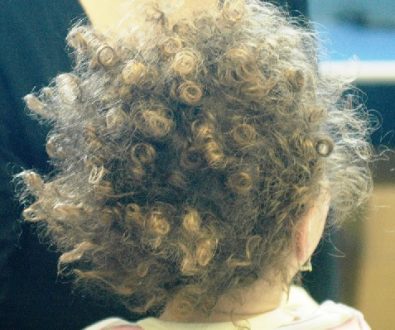The structure of the scalp hair is abnormal in wooly hair syndrome. It’s a rare form of skin disease which is characterized by the extreme growth of the hair. Wooly hair syndrome symptoms may appear after birth or in the early stages of life. The fragility of the hair increases and the average size of the curl is 0.5 cm.
Combining the hair is a daunting task. As the heavy curls in hair won’t allow smooth combing. Patients suffering from wooly hair syndrome have normal hair growth but the anagen phase in the cycle of hair development is boosted. This will affect the length of the hair. The hair will remain short. There are two cases, either the distribution of the wooly hairs is throughout the head or it is restricted to one specific area.
The partial distribution of the wooly hairs is seen in adulthood normally rather than in children. Hypotrichosis is a common condition that is usually associated with wooly hair syndrome. It is essential to rule out other medical conditions while diagnosing wooly hair syndrome.
Wooly Hair Syndrome Symptoms
The symptoms of wooly hair syndrome will vary from person to person. This condition is still under extensive clinical research. Different age groups may experience a variety of symptoms that do not mimic the symptoms documented in the books.
Human phenotype Ontology is the department that has collected the information and documented the symptoms of wooly hair syndrome. The information is based on the findings of different clinical resources like journals and research papers. The best thing about this organization is that it is updated regularly.
Following symptoms are commonly experienced by wooly hair syndrome patients:
- Brittle hair is one of the main symptoms. The hair will lose and break easily even when you comb.
- The texture and shaft of the hair are badly affected.
- Kinked hair
- Hypopigmentation of hair is common which means the color of the hair fades away.
- The growth of the hair slows.
Wooly Hair Syndrome Causes
The exact cause of wooly hair syndrome is still not clear. Genetics is one of the major causes of this disease. It is important to overlook the family history. The autosomal recessive form is not encountered very often. Follicular mosaicism can be an assumption in the case of partial hair growth.
If the condition is hereditary then the hair on the body will not be affected. The severity of the wooly hair syndrome usually slows down with age. If the child faces this syndrome, then eventually the severity will decrease with the advancement in age.
Teeth abnormalities, retinal anomalies are also considered some of the causes of wooly hair syndrome. The hair color of the wooly hair will be lightest when compared to the natural hair of the head.
Wooly Hair Syndrome Diagnosis
A detailed dermatological exam is required to diagnose wooly hair syndrome. The whole integumentary system should be evaluated. Associated manifestations should be reported along with the diagnosis. This will give the physician or any other health care professional a clear picture.
When the hair shafts are examined under the microscope, there is an elliptical cross-section with kinked hair. Non-homogenous keratinization is commonly observed in patients with wooly hair syndrome. Trichorrhexis nodosa is commonly seen in a few cases.
The manifestations of the disease are less prominent when the person reaches the adult stages. Sometimes, the diagnosis of wooly hair syndrome is confused with other diseases. The health care professional must have counseling sessions along with extensive diagnostic tests and examinations.
Wooly Hair Syndrome Treatment
There is no general treatment for wooly hair syndrome at the moment. The excision of wooly hair nevi through surgical approaches can be a viable treatment. Chemical cosmetic treatments should be avoided in the treatment of wooly hair syndrome.
An extensive internal investigation is required for the diagnosis of wooly hair syndrome. The treatment approach is decided according to the patient’s needs and requirements. The condition and severity of the disease also matter. Moreover, the cardiological diagnostic examination is necessary to start the treatment regime.
The larger nevi should be treated with the serial excision. Mechanical abrasive techniques should not be preferred as they might cause external or internal injuries.
 Health & Care Information
Health & Care Information



